Illustrated information
A presentation of the Nobel Prize in Physics 1997, based on material from the 1997 Physics Nobel poster from the Royal Academy of Sciences.
The Nobel Prize in Physics 1997
The Royal Swedish Academy of Sciences has awarded the 1997 Nobel Prize in Physics jointly to
Steven Chu, Claude Cohen-Tannoudji and William D. Phillips
for their developments of methods to cool and trap atoms with laser light.
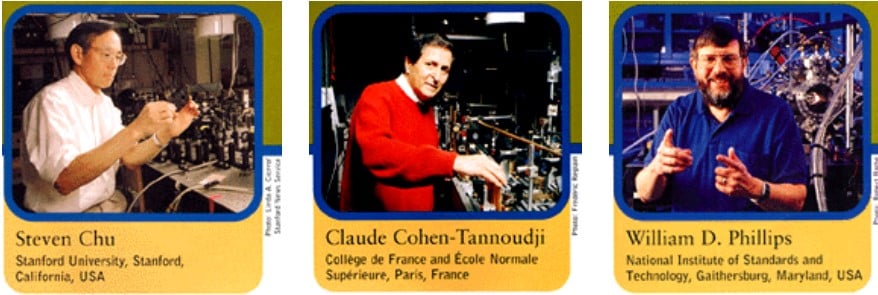

This year’s Nobel Prize laureates in physics have developed methods of cooling and trapping atoms by using laser light. Their research is helping us to study fundamental phenomena and measure important physical quantities with unprecedented precision.
Deceleration of atoms
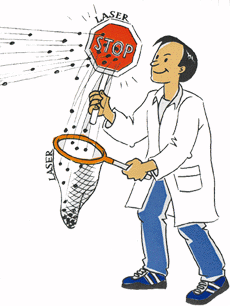
Light acts mechanically on material objects, which means it can change their positions and velocities. This mechanical action of light is used in laser cooling and trapping to reduce the velocity spread for a collection of atoms (cooling), or to confine the atoms in a small volume (trapping).
A breakthrough was achieved in the early 1980s when William Phillips developed new methods of decelerating a fast atom beam. In 1985 the first reports came from experiments where the mean velocity had been reduced from 1000 m/s to zero.
MOT
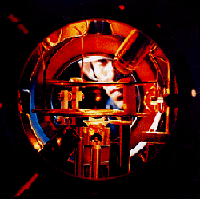
To achieve trapping, the light must induce a position-dependent force on the atoms (in contrast to cooling which requires a velocity-dependent force). Different types of atom trap have been designed. The most often used is the Magneto-Optical Trap (MOT). In a MOT, trapping is accomplished with three pairs of counter-propagating laser beams and an inhomogeneous magnetic field.
Optical molasses
The next breakthrough came in the same year when Steven Chu cooled atoms in three dimensions, using Doppler cooling with three pairs of counter-propagating laser beams. In this configuration an atom, regardless of what direction it is moving, will encounter a friction force. In this way the velocity spread (and the temperature) will be reduced. The action of the laser light on the atoms is like that of a sticky medium, giving rise to the term optical molasses.
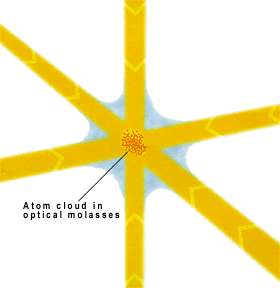
The Doppler limit
There is a limit for how cold atoms can get with Doppler cooling. In 1988 Phillips developed a time-of-flight method for measuring, and showed that the temperature was considerably below the Doppler limit. Apparently there were other cooling mechanisms at work in the optical molasses.
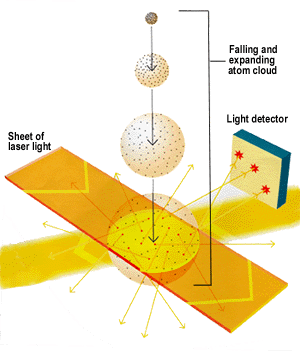
Time-of-flight method
The six laser beams are switched off. The atom cloud expands in a way determined by its temperature, at the same time as the atoms fall. They fall through a sheet of laser light and the resulting fluorescence is recorded. Since the atom cloud has expanded the signal has a temporal spread. By measuring this spread the temperature of the cloud can be determined.
New cooling mechanisms
Explanations of the low temperatures were found by Claude Cohen-Tannoudji and by Steven Chu. These were based on the fact that the polarisation of the laser field varies with position in the optical molasses.
One example of the new cooling mechanisms is Sisyphus cooling, where the concepts of light shift and optical pumping play an important role.
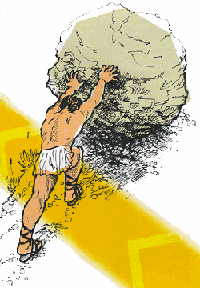
Greek mythology has it that Sisyphus must endlessly roll a stone up a hill in the Underworld. As soon as he reaches the top the stone rolls down again.
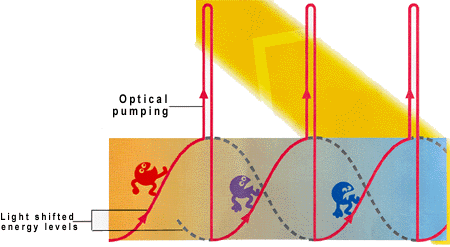
Sisyphus cooling
The atoms move on a sinusoidally modulated potential surface, which occurs through changes in their energy levels when they interact with light (light shift). When they travel ‘uphill’ they lose speed. As they reach the top of the ‘hill’ they are optically pumped to the bottom of a ‘valley’. In this way the atoms will always travel ‘uphill’, and thus their velocity will gradually be reduced. This physical picture was developed by Cohen-Tannoudji.
Below the recoil limit
The cooling methods described so far are limited by recoils from scattered photons. This means that as long as the atoms scatter light it is impossible to reach temperatures corresponding to lower velocities that is induced by a single recoil. In order to cool below the recoil limit, the laser light must be rendered ‘invisible’ to the atoms while they are being cooled. Cohen-Tannoudji invented a method termed VSCPT (Velocity-Selective Coherent Population Trapping), and Chu another one termed Raman cooling. Recently Cohen-Tannoudji’s group used VSCPT to cool helium atoms to one thousandth of the recoil limit.
Rings on the water
Over a hundred research groups are now working on laser cooling. Many applications have been tried such as atom optics, atom interferometry, atom lithography, atom clocks, optical lattices, optical tweezers, Bose-Einstein condensation, atom lasers, high-resolution spectroscopy and fundamental investigations of the interaction between light and matter.
Further reading
Information about the Nobel Prize in Physics 1997 (press release), The Royal Swedish Academy of Sciences.
Cooling and Trapping Atoms, by W.D. Phillips and H.J. Metcalf, Scientific American, Marh 1987, p. 36
New Mechanisms for Laser Cooling, by C. N. Cohen-Tannoudji and W. D. Phillips, Physics Today, October 1990, p. 33
Laser Trapping of Neutral Particles, by S. Chu, Scientific American, February 1992, p. 71
Experimenters Cool Helium below Single-Photon Recoil Limit in Three Dimensions by G. B. Lubkin, Physics Today, January 1996, p. 22
Credits and References for the 1997 Physics Nobel Poster
Editors: Solgerd Björn-Rasmussen and Margareta Wiberg Roland, The Royal Swedish Academy of Sciences.
Authors: Prof. Carl Nordling, Uppsala University, Member of the Royal Swedish Academy of Sciences and Dr. Anders Kastberg, Stockholm University.
Layout: Andreas Lilius, Typoform.
Printed by: Tryckindustri 1997.
Copyright © The Royal Swedish Academy of Sciences, Information Department, Box 50005, S-104 05 Stockholm, Sweden, Tel. +46-8-6739500, Email: rsas@kva.se.
Web adapted version: Nobelprize.org
Every effort has been made by the publisher to credit organizations and individuals with regard to the supply of photographs and illustrations. The publishers apologize for any omissions which will be corrected in future editions.
Nobel Prizes and laureates
Six prizes were awarded for achievements that have conferred the greatest benefit to humankind. The 12 laureates' work and discoveries range from proteins' structures and machine learning to fighting for a world free of nuclear weapons.
See them all presented here.
